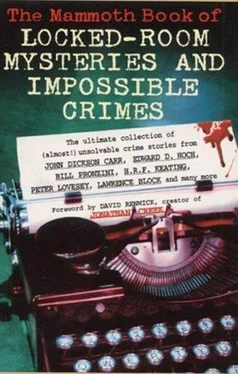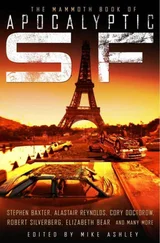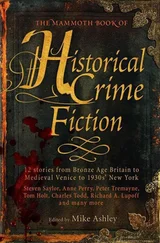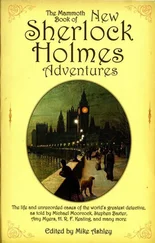Mike Ashley - The Mammoth Book of Locked-Room Mysteries And Impossible Crimes
Здесь есть возможность читать онлайн «Mike Ashley - The Mammoth Book of Locked-Room Mysteries And Impossible Crimes» весь текст электронной книги совершенно бесплатно (целиком полную версию без сокращений). В некоторых случаях можно слушать аудио, скачать через торрент в формате fb2 и присутствует краткое содержание. Жанр: Детектив, на английском языке. Описание произведения, (предисловие) а так же отзывы посетителей доступны на портале библиотеки ЛибКат.
- Название:The Mammoth Book of Locked-Room Mysteries And Impossible Crimes
- Автор:
- Жанр:
- Год:неизвестен
- ISBN:нет данных
- Рейтинг книги:3 / 5. Голосов: 1
-
Избранное:Добавить в избранное
- Отзывы:
-
Ваша оценка:
- 60
- 1
- 2
- 3
- 4
- 5
The Mammoth Book of Locked-Room Mysteries And Impossible Crimes: краткое содержание, описание и аннотация
Предлагаем к чтению аннотацию, описание, краткое содержание или предисловие (зависит от того, что написал сам автор книги «The Mammoth Book of Locked-Room Mysteries And Impossible Crimes»). Если вы не нашли необходимую информацию о книге — напишите в комментариях, мы постараемся отыскать её.
A new anthology of twenty-nine short stories features an array of baffling locked-room mysteries by Michael Collins, Bill Pronzini, Susanna Gregory, H. R. F. Keating, Peter Lovesey, Kate Ellis, and Lawrence Block, among others.
The Mammoth Book of Locked-Room Mysteries And Impossible Crimes — читать онлайн бесплатно полную книгу (весь текст) целиком
Ниже представлен текст книги, разбитый по страницам. Система сохранения места последней прочитанной страницы, позволяет с удобством читать онлайн бесплатно книгу «The Mammoth Book of Locked-Room Mysteries And Impossible Crimes», без необходимости каждый раз заново искать на чём Вы остановились. Поставьте закладку, и сможете в любой момент перейти на страницу, на которой закончили чтение.
Интервал:
Закладка:
The other publication was a Sherlock Holmes story, “The Adventure of the Speckled Band” ( The Strand Magazine , February 1892). The immediate success of the Holmes stories in The Strand is well known. Arthur Conan Doyle was fascinated with the idea of unusual crimes, and what makes the Holmes stories stand out is that all of the crimes are bizarre, a real test for Holmes’s deductive powers. Holmes had no interest in the run-of-the-mill crime. Perhaps, because of that, it is surprising that there are not more impossible crimes amongst the Holmes canon. Strictly there are only two, the other being “The Problem of Thor Bridge” ( The Strand Magazine , February 1922) where a murder is committed but no visible weapon.
The Big Bow and “Speckled Band”, coming together just at the time when the popular fiction magazine was blossoming, opened the door for the impossible crime story. The late Victorian and Edwardian writers loved them. Conan Doyle wrote one further example, “The Story of the Lost Special” ( The Strand Magazine , August 1898) where a train vanishes from a stretch of rail. L.T. Meade produced ever more bizarre solutions to her crimes, especially those collected in A Master of Mysteries (1898).
The next major breakthrough, however, came in 1905. In America the author Jacques Futrelle published “The Problem of Cell 13” as a serial in The Boston American (30 October – 5 November 1905), challenging the newspaper’s readers to solve the story. It introduced Futrelle’s character Professor S.F.X. Van Dusen, known as the Thinking Machine, who has such a power of deduction that he is able to resolve any problem, no matter how impossible it seems. In this first story he set himself the challenge of escaping from a locked cell in a high-security prison, kept constantly under watch. How he did it remains one of the most remarkable stories ever written. Over the next six years Futrelle wrote several dozen Thinking Machine stories, not all of which appeared in book-form. They included stories in which things disappear from guarded rooms, a car vanishes from a stretch of road, and even an entire house disappears. It was such a tragedy that Futrelle was killed when the Titanic sank in 1912.
It was also in 1905 that Edgar Wallace published The Four Just Men , along with much publicity and gimmickry. Wallace had published the book himself and deliberately left the ending open, offering a prize to the reader who could solve the baffling murder of a man in broad daylight surrounded (but not touched) by policemen in a locked room. Needless to say the redoubtable Edgar Wallace employed the locked-room idea many times in his books and stories, with perhaps the most ingenious being in The Crimson Circle (1922), where a man is found gassed in a locked room.
Soon after The Four Just Men came one of the most popular of all locked-room mysteries, The Mystery of the Yellow Room (1908). The author was Gaston Leroux, best known for The Phantom of the Opera (1911). The novel, which is still in print, is one of the best developed of all locked-room deaths, and is all the more fun because of the rivalry between the detective, Frederick Larson, and the newspaper reporter, Joseph Rouletabille, to solve the crime.
If the impossible crime story needed any final seal of approval it came in 1911 with the publication of The Innocence of Father Brown by G.K. Chesterton. The stories had already caused a sensation in The Story-Teller , where they had started to appear from the September 1910 issue. The editor of The Story-Teller , Arthur Spurgeon, was so impressed by the stories that he announced them with the proclamation that: “the plots are so amazing and so cleverly worked out that I believe they will prove to be the best detective stories of our time.” There were in total five volumes of Father Brown stories, many of them falling into the category of the impossible crime, especially those in The Incredulity of Father Brown (1926).
By another remarkable instance of synchronicity, at the same time as Father Brown appeared so did Melville Davisson Post’s Uncle Abner. Although the first collection, Uncle Abner, Master of Mysteries , did not appear until 1918, the stories were being run in The Saturday Evening Post and other magazines from 1911 on. Alas, all too few of them are miracle murders, though the best, “The Doomdorf Mystery”, which David Renwick refers to and which is reprinted in this anthology, most certainly was.
Chesterton and Post provide the link across the Great War and into the 1920s. There were less impossible crime stories written during this period than one might expect, though the form was well enough established for P.G. Wodehouse to spoof it in the perfectly acceptable “The Education of Detective Oakes” ( Pearson’s Magazine , December 1914), where a man in a locked room appears to have been killed by snake venom.
S.S. van Dine, the creator of Philo Vance, gave it a good stab in The Canary Murder Case (1927) and later novels. Agatha Christie also turned her mercurial mind to the matter. Several of the stories in The Thirteen Problems (1932), such as “The Blue Geranium” ( The Story-Teller , December 1929) are seemingly impossible crimes which Miss Marple is able to solve simply by applying her mind.
It was now, though, that the real doyen of the impossible crime story emerged onto the scene – John Dickson Carr. Carr had started writing when he was at Haverford College, Pennsylvania, placing stories in the college magazine, The Haverfordian. His third story, “The Shadow of the Goat” (November-December 1926) was his first locked-room murder and also introduced his detective Henri Bencolin. It’s an ingenious crime involving both a disappearance from a locked room and a murder in a house both locked and guarded. Carr was perfecting his craft from an early age – he was only twenty when these appeared. A later Bencolin serial, “Grand Guignol” ( The Haverfordian , March-April 1929) was expanded into Carr’s first novel, It Walks By Night (1930).
Over the next forty years Carr was to write over fifty novels featuring impossible crimes, plus numerous short stories. It is impossible to list them all here, but I must single out a few. Probably the classic of them all is The Hollow Man (1935), also published under the title The Three Coffins. When, in 1980, Edward Hoch conducted a poll amongst a panel of seventeen experts on mystery fiction, this novel came out head-and-shoulders above the rest. It involves two impossible murders – a death in a locked and guarded room and a death in a snow-covered street with no footprints. The book features Carr’s best known detective, Dr Gideon Fell, and is notorious for the fact that Carr stops the action at a crucial point to allow Fell to deliver a lecture about the locked-room crime and the various ways in which it can be achieved. The book – and the lecture – remain models of their kind.
There were three other Carr novels in the experts’ top ten. The Crooked Hinge (1938), another Gideon Fell novel, came in fourth. This provides a slightly less satisfying but nevertheless intriguing solution to a murder in the sand with none but the victim’s footprints. The Judas Window (1938), published under his Carter Dickson alias, and mentioned by David Renwick in his Foreword, was voted fifth. I personally rate this as Carr’s best constructed novel – ingenious, surprisingly plausible, and riveting. It features Carr’s detective Henry Merrivale, as does The Ten Teacups (1937), also known as The Peacock Feather Murders , and tenth on the experts’ list. In fact the Henry Merrivale mysteries include some of the most unusual impossible murders such as those in The Plague Court Murders (1934), The Unicorn Murders (1935) and The Red Widow Murders (1935).
Читать дальшеИнтервал:
Закладка:
Похожие книги на «The Mammoth Book of Locked-Room Mysteries And Impossible Crimes»
Представляем Вашему вниманию похожие книги на «The Mammoth Book of Locked-Room Mysteries And Impossible Crimes» списком для выбора. Мы отобрали схожую по названию и смыслу литературу в надежде предоставить читателям больше вариантов отыскать новые, интересные, ещё непрочитанные произведения.
Обсуждение, отзывы о книге «The Mammoth Book of Locked-Room Mysteries And Impossible Crimes» и просто собственные мнения читателей. Оставьте ваши комментарии, напишите, что Вы думаете о произведении, его смысле или главных героях. Укажите что конкретно понравилось, а что нет, и почему Вы так считаете.










